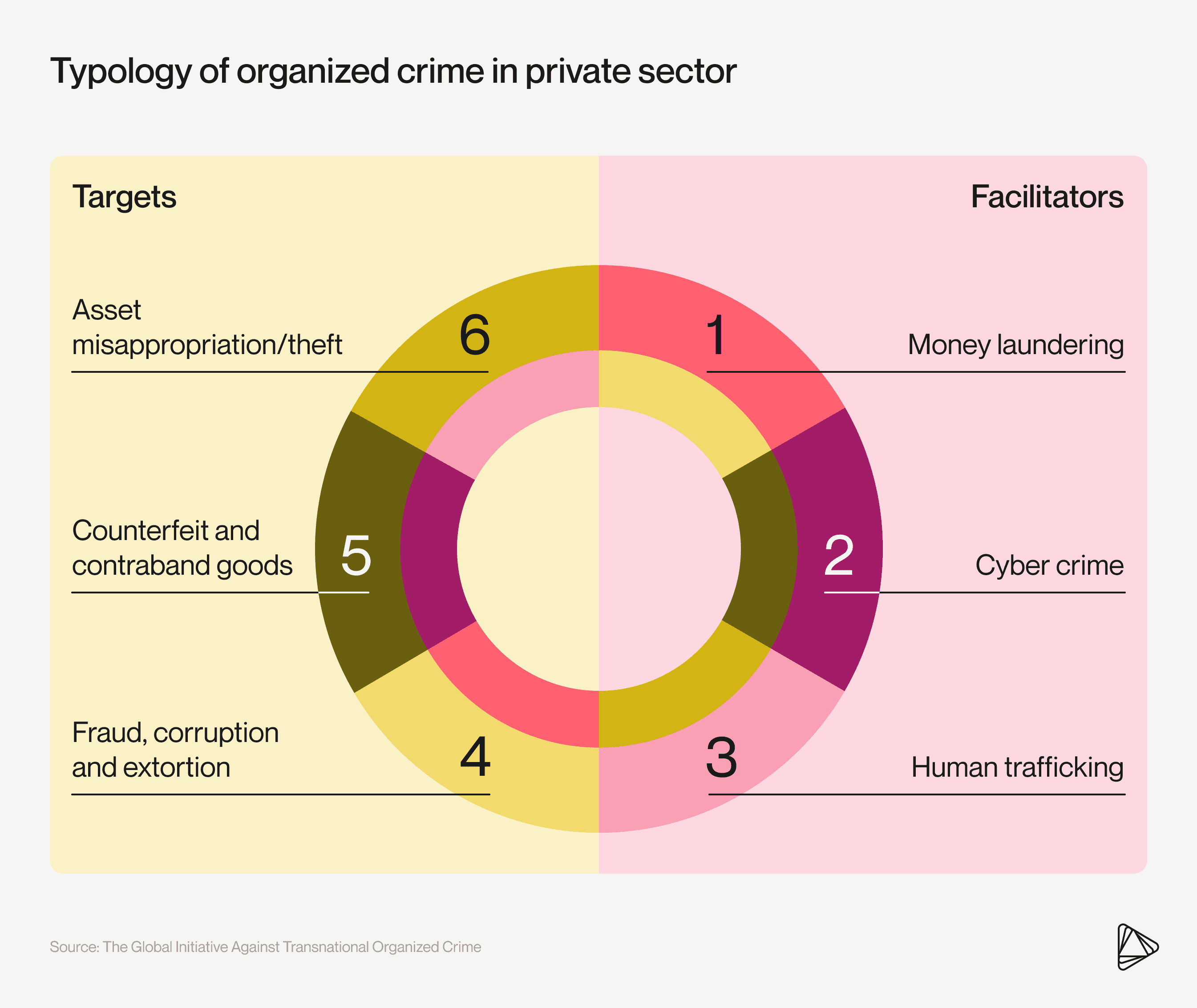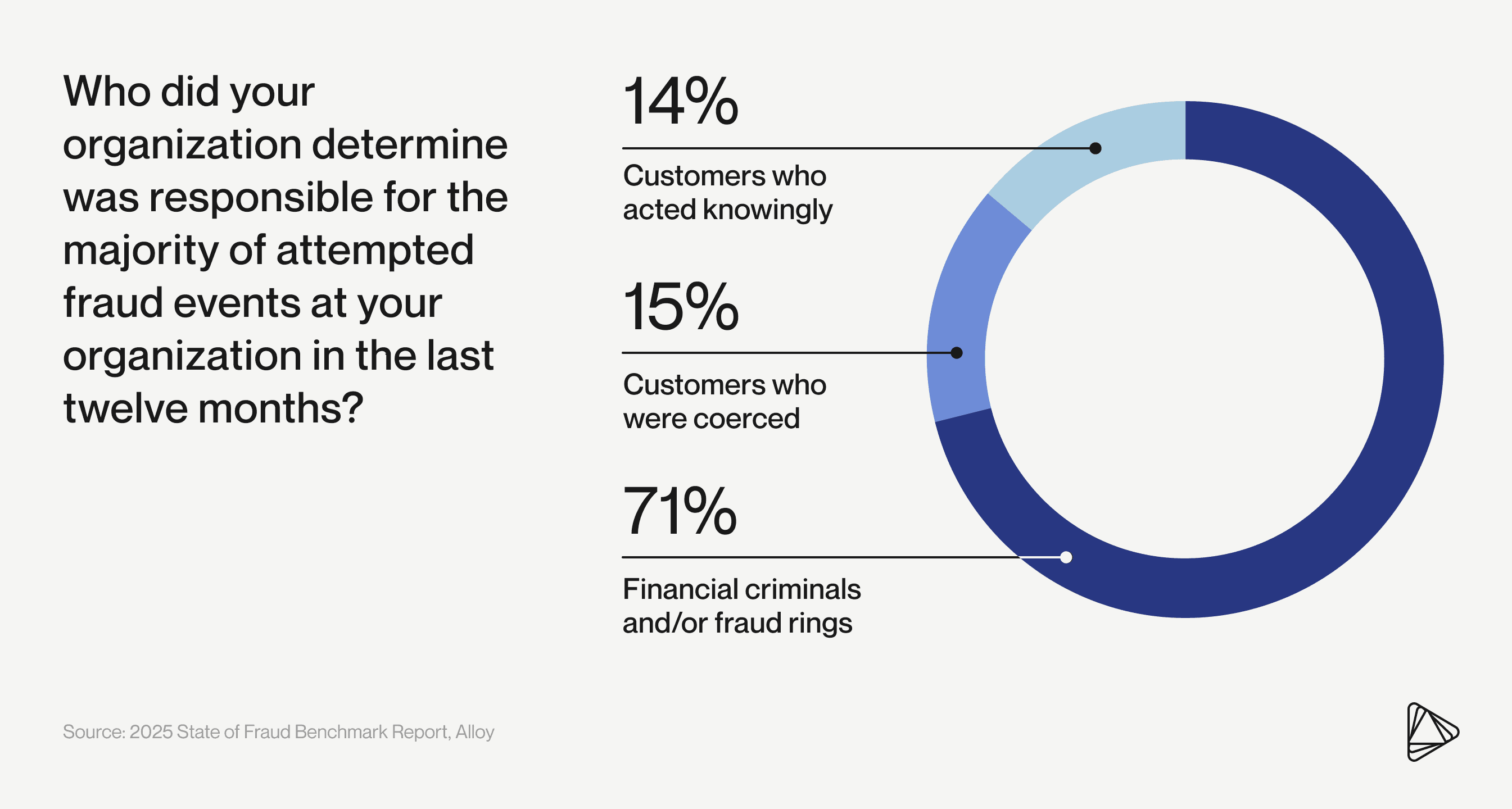Share
How can financial institutions and fintechs stop crime ring attacks?
Jun 4, 2025
Tactics include identity-proofing infrastructure and investing in actionable AI.

Crime rings are becoming increasingly sophisticated in their attacks, costing the finance industry billions annually. These organized criminal networks leverage fake identities, repeatable fraud schemes, and emerging technologies like generative AI to systematically exploit vulnerabilities in financial systems.
The consequences of their attacks extend far beyond financial losses. Victims often face devastating personal impacts, including damaged credit scores, drained retirement savings, and severe emotional trauma. Some never fully recover from the financial and psychological effects of being targeted by organized fraud.
For financial institutions and fintechs, stopping crime rings requires more than just traditional fraud prevention — it demands an actionable, multi-layered approach to detecting and preventing organized attacks that protects both systems and customers.
What is a crime ring?
A crime ring is an organized network of criminals who regularly collaborate on illegal activities. In a sense, crime rings work like any business, operating with specific roles and hierarchies. These groups tend to specialize in a particular type of crime, like theft, drug trafficking, or financial fraud. They often have established territories or spheres of influence and launder money through their connections to legitimate businesses.

Source: The Global Initiative Against Transnational Organized Crime
How many fraudsters does it take to form a crime ring?
The reality is that crime rings vary significantly in size, ranging from local “fraud startups” with just a few actors to massive international networks with hundreds or even thousands of members.
Small crime rings might consist of 3-10 people working together on localized schemes, while mid-sized operations typically involve 10-50 members and more complex organizational structures. Large-scale crime rings can include hundreds of core operators and money launderers, plus thousands of money mules, recruiters, and other lower-level participants.
Who do crime rings target?
Crime rings can inflict devastating harm that extends far beyond financial losses, inflicting emotional distress on victims of all types and contributing to criminal epidemics like human trafficking and modern slavery. Their targets include:
Individual consumers
Crime rings frequently launch mass scam campaigns targeting the general public. Using automated tools and social engineering, they blast fraudulent messages across email, social media, and phone channels, hoping to catch anyone willing to engage. These attacks often lead to identity theft, account takeover, and monetary losses that create a chain reaction of fraud.
Vulnerable populations
People in transitional states are especially susceptible to crime ring attacks. This includes:
- Elderly people with retirement savings
- Job seekers facing unemployment
- Young or undocumented individuals
- People seeking romantic connections online
- Individuals experiencing medical emergencies
By targeting those facing situational vulnerabilities like financial instability, crime rings can encourage victims who already feel a sense of urgency to engage in a quick transaction that leaves them empty-handed, hurt, or even in danger.
High-value targets
Crime rings may specifically pursue wealthy individuals, corporate executives, and others with substantial assets or access to company funds. These attacks tend to be more targeted and sophisticated, often involving extensive research and social engineering. (Consider, for instance, the finance worker who was duped into paying out $25 million to fraudsters using deepfake technology to pose as the company’s CFO.)
Retail and other businesses
Organized retail crime (ORC) is a criminal enterprise that uses a network of individuals to steal large quantities of merchandise from various retail stores. The stolen goods are then resold through fencing operations for profit. Beyond physical theft, retailers and other businesses may face significant losses from chargeback fraud, where criminals make purchases with stolen payment information or fraudulently dispute legitimate transactions.
Financial organizations
Financial institutions and fintechs face direct attacks through account takeovers, synthetic identity fraud, and sophisticated money laundering schemes that exploit gaps in security infrastructure and compliance programs. When criminals successfully compromise individual victims, they often use those stolen credentials and accounts to launch larger-scale attacks against financial organizations.
"Fraud rings aren’t petty criminals with laptops — they’re sophisticated, organized operations that weaponize our digital lives against us. For individuals, they can mean financial ruin. For financial institutions, they’re an existential threat that strikes at the heart of trust. As fraud rings grow more coordinated and tech-savvy, the only way to fight back is with equal coordination, faster intelligence-sharing, and a willingness to think like the criminals do — without becoming them."
— Erin West, Expert in Transnational Organized Scams and Founder of Operation Shamrock
How do crime rings commit financial fraud?
Crime rings use tactics like emotional manipulation and social engineering to disarm consumers, promising false opportunities in exchange for immediate payment. Incentives might include a financial windfall in the case of investment scams, a dream career move in the case of job scams, or even a love affair in the case of romance scams.
Crime rings targeting financial organizations might pose as good customers to open fraudulent accounts, take over existing customer accounts through stolen credentials (ATO fraud), or exploit vulnerabilities in financial systems. Once they gain access, they might max out credit without intending to repay (“bust-out” fraud), exploit ATM float times for check fraud, or use compromised targets as "drop accounts" to temporarily store stolen funds before transferring them through mule accounts.
Want to learn about more fraud types? Check out our glossary.
Crime rings rely on a number of methods and tools to carry out successful fraud attacks:
They leverage fake and stolen identities.
There’s a limit to how many times someone can commit financial fraud using their real identity. The ongoing nature of organized criminal activity — and the fact that crime rings operate within specific niches — means that, eventually, their targets will catch on.
But fake identities open new doors. On the consumer front alone, most of the 2.6 million fraud reports filed with the Federal Trade Commission (FTC) in 2024 were imposter scams, a majority that has remained consistent year after year.

Source: Scammy Snapshot of 2024, FTC
Decision-makers at financial organizations reported a similar trend: According to Alloy’s 2025 State of Fraud Benchmark Report, inconsistent user behaviors and device characteristics were the most common signs of attempted fraud last year, followed by applications with inconsistent personally identifiable information (PII).

To make a fake identity convincing, financial crime rings will either equip themselves with stolen identities or generate new ones using a blend of real and falsified PII. It isn’t unusual for financial criminals to stockpile these hybrid personas, known as synthetic identities, for years to accumulate a convincing digital footprint or credit history in the lead-up to a fraud attack.
They recycle profitable techniques.
Crime rings typically attack institutions in the same way, through shared methods that repeat over time until they are phased out or no longer work. Examples of reusable processes or techniques include:
- Vulnerability assessment — Crime rings typically "poke" before they attack to assess how a financial institution or fintech’s system will respond to an attack. Once a fraud ring spots a weakness in a system, they will test for the same weakness across financial organizations with similar profiles.
- Script and playbook writing — Crime rings will reuse scripts that effectively convince consumers to give away funds. Successful scripts and fraud playbooks may be shared amongst members to more effectively target consumers on channels like social media, phone, or email.
- Scamming account holders — Crime rings scam account holders in systematic ways, using techniques like card skimming, device theft, or even SIM cloning to obtain PII and bypass controls.
- Fake identity creation — Crime rings will repeat identity falsification processes that result in the most believable and lucrative fake IDs.
A crime ring’s ability to repurpose techniques that are successful and dump those that don’t work is a part of what enables them to commit regular fraud attacks.
Crime rings use generative AI to enhance performance.
Generative artificial intelligence (GenAI) has fundamentally transformed how crime rings operate, making them more dangerous and effective than ever before. By 2027, GenAI-powered fraud is predicted to cost financial institutions $40 billion in fraud losses.
This technology has become a force multiplier for crime rings in key ways:
- Increased efficiency — GenAI allows fraud rings to automate and accelerate their operations, generating thousands of convincing fake identities, fraudulent documents, and scam messages in minutes rather than days.
- Lower barriers to entry — Many of the technical limitations that once restricted fraud operations have vanished with GenAI. These tools can instantly generate professional-quality content in any language, enabling crime rings worldwide.
- Enhanced believability — Crime rings can now produce ultra-realistic deepfake videos, voice clones, and doctored images that are nearly indistinguishable from genuine content.
- Improved targeting — While AI helps fraud rings analyze vast amounts of data to identify vulnerable targets, GenAI enables personalization at scale, enhancing effectiveness.
Thanks to these AI capabilities, even smaller crime rings can now execute complex fraud schemes that were previously only possible for the most sophisticated criminal organizations. This democratization of advanced fraud techniques has created an unprecedented surge in organized financial crime.
GenAI isn’t the lifeline financial organizations think it is. Here’s why.
How big of a problem are crime rings?
In part because of the boost they’ve gotten from GenAI, financial institutions, fintechs, and their regulators recognize crime rings as a major threat to the financial system. Through the Bank Secrecy Act, FinCEN requires financial organizations to maintain strong anti-money laundering programs and report suspicious activities that could indicate organized crime. These requirements show how seriously regulators take the fight against financial crime rings.
The bad news: Crime rings are widespread and hard-hitting.
According to Alloy’s benchmark report, 71% of financial organizations identified professional crime rings as the primary perpetrators of fraud attacks against their organization.

In 2024, 60% of financial organizations reported an increase in fraud across consumer and business accounts. At the same time, 2.6 million fraud reports were filed by consumers — on par with previous years. However, the number of people who experienced monetary losses due to fraud rose from one in four (25%) to one in three (33%) in 2024, with total losses reaching $12.5 billion — up $2.5 billion from 2023.

Source: Scammy Snapshot of 2024, FTC
The good news: Crime rings can be identified.
Crime rings need repeatable processes to operate at scale — and that's their weakness. While their specific tactics vary, crime rings follow observable patterns. They typically operate in stages: first, probing for vulnerabilities through test transactions and suspicious application patterns; then, executing attacks.
Modern identity and fraud prevention solutions tap into vast data networks to identify these signatures, while actionable AI enables financial institutions to detect and respond to coordinated attacks.
What will it take to stop crime rings from committing fraud attacks?
Every successful attack gives crime rings more resources to fund their next scheme. Like startups, these fraud rings are investing in better technology and smarter tactics.
The key to stopping them? Focus on identity from the start. Most financial organizations still rely heavily on transaction monitoring to catch fraud — but, by then, it's often too late.
[callout] Identity-first fraud prevention protects you and your customers throughout the lifecycle of the relationship, including:
- At onboarding — Assess risk before accounts are opened by detecting fraud indicators in application patterns, device signatures, and synthetic identity markers
- After onboarding — Monitor ongoing account interactions to spot suspicious behavior patterns and potential crime ring attacks before losses occur.
This shift in strategy does more than just prevent losses — it fundamentally changes the economics of fraud. When crime rings have to work harder to create convincing identities and constantly adapt to new detection methods, their costs go up while their success rates drop. Eventually, attacking your financial organization simply isn't worth their time.
While you can't control the economic factors that drive fraud, you can control how quickly you detect and respond to attacks. For financial institutions and fintechs, this means having a layered, identity-centered fraud prevention solution with a "kill switch” before you need it.
How Alloy stops organized fraud attacks
When crime rings attack, financial institutions need a proven response plan. Alloy's identity and fraud prevention platform delivers comprehensive protection through:
- Rapid detection and triage with actionable AI — Instantly identify attack type and severity, automatically deploying targeted defensive measures to contain the threat
- Smart discovery — Leverage unified customer profiles and network intelligence to expose attack patterns and systematically close vulnerabilities
- Continuous remediation — Deploy sophisticated protections like behavioral biometrics and dynamic step-up verification precisely when needed
- Adaptive defense — Transform each attempted attack into stronger safeguards, continuously raising barriers and costs for crime rings

Source: Fraud Attack Radar, Alloy
By building identity-centered defenses that evolve with every threat, Alloy helps financial institutions and fintechs detect more fraud at onboarding.
The results speak for themselves: one leading financial institution prevented $5 in fraud losses for every $1 invested in Alloy while maintaining efficient onboarding for legitimate customers. This proactive approach doesn't just reduce institutional losses and strengthen compliance — it helps prevent the devastating personal and financial impacts that fraud has on consumers by making attacks more costly and less profitable for crime rings.
Discover how Alloy's Fraud Attack Radar uses AI to detect and stop crime rings.
Ready to turn the tables on crime rings?
It’s time to start fighting back. Learn how financial institutions use Alloy to detect, prevent, and outmaneuver organized fraud attacks.




